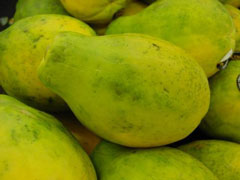


Home
Flowers &
Indoor Plants
Fruits & Nuts
Ornamentals
Vegetables
Special Topics
Resources
Glossary

|
Papaya Carica papaya (care-ih-cah pah-pie-uh)     Click on thumbnails for larger image. |
 |
What about it? This evergreen tree can grow to 25 feet and - you guessed it - is another tropical fruit that northern gardeners can only drool over in the supermarket, with no hope of growing outdoors. The leaves of the papaya are large and palmate, and up to 24 inches across. The fruit is occasionally confused with mango fruits by shoppers in northern supermarkets, since it is nearly the same size and shape. What is it used for? The ripe fruit of the papaya is delicious and nutritious. The ripe papaya is slightly soft, and is enjoyed fresh in salads or desserts. It can also be cooked or preserved. The unripe fruit and plant are used medicinally, in soap, and in cosmetics. In the tropics the unripe fruit is eaten as a vegetable. Where does it grow? How do we grow it? Papaya is grown in the tropics and in the frostless subtropics. It requires full sunlight and a well -drained, well-aerated, fertile loamy soil, preferably rich in organic matter. What are its primary problems? Mosaic is a very serious disease found on the papaya and is caused by a virus. It is transmitted by aphids, as is distortion ringspot virus. Bunch top is another disease found on the papaya. Insects commonly found on the papaya include the Xyleborus beetle which bores into weakened tree stems and kills the trees. Fruit flies cause rot of ripening fruits. Several mites also attack the papaya. How do we harvest and store it? Papaya fruit is picked when the green color changes into yellow. The latex that is exuded from the fruit can be irritating, so pickers should wear gloves. The fruit is cut off with a knife.
© Copyright, Department of Horticulture, Cornell University. |